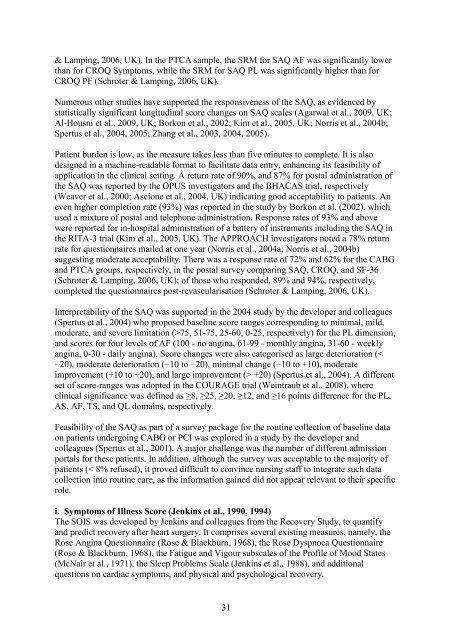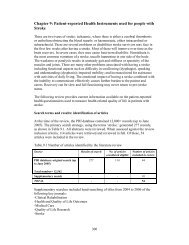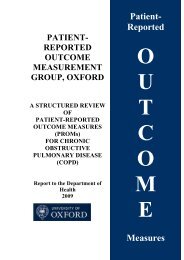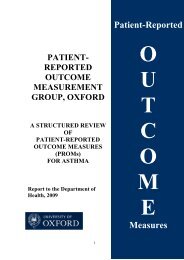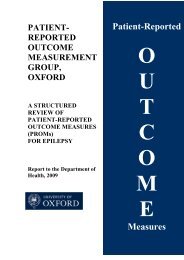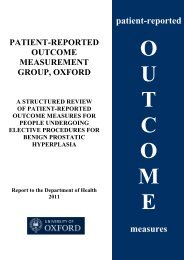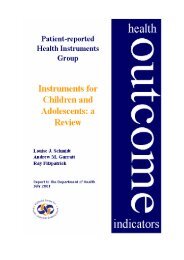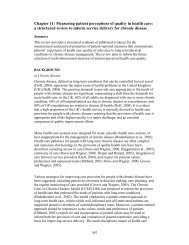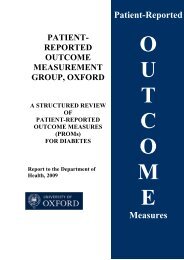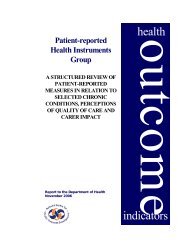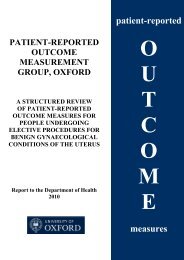2010 review - Patient-Reported Outcomes Measurement - University ...
2010 review - Patient-Reported Outcomes Measurement - University ...
2010 review - Patient-Reported Outcomes Measurement - University ...
Create successful ePaper yourself
Turn your PDF publications into a flip-book with our unique Google optimized e-Paper software.
& Lamping, 2006, UK). In the PTCA sample, the SRM for SAQ AF was significantly lower<br />
than for CROQ Symptoms, while the SRM for SAQ PL was significantly higher than for<br />
CROQ PF (Schroter & Lamping, 2006, UK).<br />
Numerous other studies have supported the responsiveness of the SAQ, as evidenced by<br />
statistically significant longitudinal score changes on SAQ scales (Agarwal et al., 2009, UK;<br />
Al-Housni et al., 2009, UK; Borkon et al., 2002; Kim et al., 2005, UK; Norris et al., 2004b;<br />
Spertus et al., 2004, 2005; Zhang et al., 2003, 2004, 2005).<br />
<strong>Patient</strong> burden is low, as the measure takes less than five minutes to complete. It is also<br />
designed in a machine-readable format to facilitate data entry, enhancing its feasibility of<br />
application in the clinical setting. A return rate of 90%, and 87% for postal administration of<br />
the SAQ was reported by the OPUS investigators and the BHACAS trial, respectively<br />
(Weaver et al., 2000; Ascione et al., 2004, UK) indicating good acceptability to patients. An<br />
even higher completion rate (93%) was reported in the study by Borkon et al. (2002), which<br />
used a mixture of postal and telephone administration. Response rates of 93% and above<br />
were reported for in-hospital administration of a battery of instruments including the SAQ in<br />
the RITA-3 trial (Kim et al., 2005, UK). The APPROACH investigators noted a 78% return<br />
rate for questionnaires mailed at one year (Norris et al., 2004a; Norris et al., 2004b)<br />
suggesting moderate acceptability. There was a response rate of 72% and 62% for the CABG<br />
and PTCA groups, respectively, in the postal survey comparing SAQ, CROQ, and SF-36<br />
(Schroter & Lamping, 2006, UK); of those who responded, 89% and 94%, respectively,<br />
completed the questionnaires post-revascularisation (Schroter & Lamping, 2006, UK).<br />
Interpretability of the SAQ was supported in the 2004 study by the developer and colleagues<br />
(Spertus et al., 2004) who proposed baseline score ranges corresponding to minimal, mild,<br />
moderate, and severe limitation (>75, 51-75, 25-60, 0-25, respectively) for the PL dimension,<br />
and scores for four levels of AF (100 - no angina, 61-99 - monthly angina, 31-60 - weekly<br />
angina, 0-30 - daily angina). Score changes were also categorised as large deterioration (<<br />
−20), moderate deterioration (−10 to −20), minimal change (−10 to +10), moderate<br />
improvement (+10 to +20), and large improvement (> +20) (Spertus et al., 2004). A different<br />
set of score-ranges was adopted in the COURAGE trial (Weintraub et al., 2008), where<br />
clinical significance was defined as ≥8, ≥25, ≥20, ≥12, and ≥16 points difference for the PL,<br />
AS, AF, TS, and QL domains, respectively.<br />
Feasibility of the SAQ as part of a survey package for the routine collection of baseline data<br />
on patients undergoing CABG or PCI was explored in a study by the developer and<br />
colleagues (Spertus et al., 2001). A major challenge was the number of different admission<br />
portals for these patients. In addition, although the survey was acceptable to the majority of<br />
patients (< 8% refused), it proved difficult to convince nursing staff to integrate such data<br />
collection into routine care, as the information gained did not appear relevant to their specific<br />
role.<br />
i. Symptoms of Illness Score (Jenkins et al., 1990, 1994)<br />
The SOIS was developed by Jenkins and colleagues from the Recovery Study, to quantify<br />
and predict recovery after heart surgery. It comprises several existing measures, namely, the<br />
Rose Angina Questionnaire (Rose & Blackburn, 1968), the Rose Dyspnoea Questionnaire<br />
(Rose & Blackburn, 1968), the Fatigue and Vigour subscales of the Profile of Mood States<br />
(McNair et al., 1971), the Sleep Problems Scale (Jenkins et al., 1988), and additional<br />
questions on cardiac symptoms, and physical and psychological recovery.<br />
31


